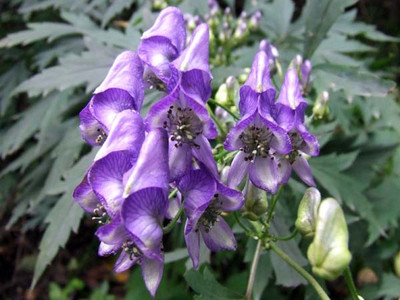- Araliaceae
- Asteraceae
- Campanulaceae
- Caryophyllaceae
- Elaeagnaceae
- Ephedraceae
- Gentianaceae
- Ginkgoaceae
- Guttiferae
- Labiatae
- Leguminosae
- Liliaceae
- Magnoliaceae
- Malvaceae
- Oleaceae
- Orchidaceae
- Orobanchaceae
- Palmae
- Poaceae
- Polygalaceae
- Ranunculaceae
- Rutaceae
- Sarraceniaceae
- Schisandraceae
- Scrophulariaceae
- Solanaceae
- Taxaceae
- Theaceae
- Thymelaeaceae
- Umbelliferae
- Valerianaceae
- Zingiberaceae

Aconitum carmichaelii Debx
- Introduction
- Published data
- Download
Aconitum carmichaelii Debx is named ‘‘Chuanwu’’ (CW, Fig. 1B), while the daughter or lateral root of Aconitum carmichaelii Debx is ‘‘Fuzi’’ (FZ, Fig. 1C). As one of the most crucial TCM drugs, FZ has been more frequently prescribed than CW to treat rheumatic diseases. It was firstly recorded in the earliest Chinese medicinal classic, Shennong’s Materia Medica.
Pubulications:
1. Sun H, Ni B, Zhang A, et al. Metabolomics study on Fuzi and its processed products using ultra-performance liquid-chromatography/electrospray-ionization synapt high-definition mass spectrometry coupled with pattern recognition analysis[J]. Analyst, 2012, 137(1): 170-185.
2. Zhao D, Shi Y, Zhu X, et al. Identification of Potential Biomarkers from Aconitum carmichaelii, a Traditional Chinese Medicine, Using a Metabolomic Approach[J]. Planta medica, 2017.
Details:
http://herbalplant.ynau.edu.cn/index.php?m=content&c=index&a=show&catid=100&id=194

Paeonia lactifora Pall
- Introduction
- Published data
- Download
White Paeony Root (WPR), the roots of Paeonia lactifora Pall., is a common traditional Chinese medicine (TCM) that is used for nourishing blood and regulating menstruation, astringing Yin to check sweating, emolliating the liver, relieving pain, and pacifying and repressing the liver Yan, in accordance with TCM theory.
Pubulications:
Ming K, Jun X U, Huan-Huan L I U, et al. Effects of boiling duration in processing of White Paeony Root on its overall quality evaluated by ultra-high performance liquid chromatography quadrupole/time-of-flight mass spectrometry based metabolomics analysis and high performance liquid chromatography quantification[J]. Chinese Journal of Natural Medicines, 2017, 15(1): 62-70.
Details:
http://herbalplant.ynau.edu.cn/index.php?m=content&c=index&a=show&catid=100&id=193

Aconitum
- Introduction
- Published data
- Download
As a widely used Chinese herbal medicine, the roots of Aconitum are commonly applied for various tumours and some endocrinal disorders.
Pubulications:
Sun H, Wang M, Zhang A, et al. UPLC–Q‐TOF–HDMS Analysis of Constituents in the Root of Two Kinds of Aconitum Using a Metabolomics Approach[J]. Phytochemical Analysis, 2013, 24(3): 263-276.
Details:
http://herbalplant.ynau.edu.cn/index.php?m=content&c=index&a=show&catid=100&id=192